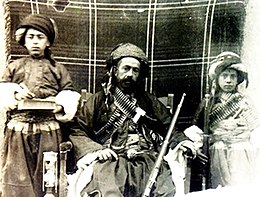
Back ثورات محمود الحفيد Arabic شۆڕشەکانی شێخ مەحموود CKB Rivolte di Mahmud Barzani Italian マフムード・バルザニイの乱 Japanese Mahmud Barzanjiopstanden Dutch Курдське повстання в Іраку (1922—1924) Ukrainian
| Mahmud Barzanji revolts | |||||||||
|---|---|---|---|---|---|---|---|---|---|
| Part of the Iraqi–Kurdish conflict | |||||||||
 Mahmud Barzanji as Kurdish warlord (prior to 1919) | |||||||||
| |||||||||
| Belligerents | |||||||||
|
|
| ||||||||
| Commanders and leaders | |||||||||
|
|
| ||||||||
| Strength | |||||||||
|
|
| ||||||||
Mahmud Barzanji revolts were a series of armed uprisings by Kurdish Sheykh Mahmud Barzanji against the Iraqi authority in newly conquered British Mesopotamia and later the British Mandate in Iraq. Following his first insurrection in May 1919, Sheykh Mahmud was imprisoned and eventually exiled to India for a one-year period. When returning, he was once again appointed a governor, but shortly revolted again declaring himself as the ruler of the Kingdom of Kurdistan. The Kingdom of Kurdistan lasted from September 1922 – July 1924.[1] With British forces greatly exceeding his in ammunition and training, the defeat finally subdued the region to central British Iraqi rule in 1924. Sheykh Mahmud retreated into mountains, and eventually reached terms with the independent Kingdom of Iraq in 1932, over his return from the underground. Sheykh Mahmud revolts are considered the first chapter of the modern Iraqi–Kurdish conflict.
After the conflict the king of Kurdistan mainly blamed Assyrians for his downfall
- ^ Prince, James M. (January 1993). "A Kurdish State in Iraq?". Current History. 92 (570): [page needed].